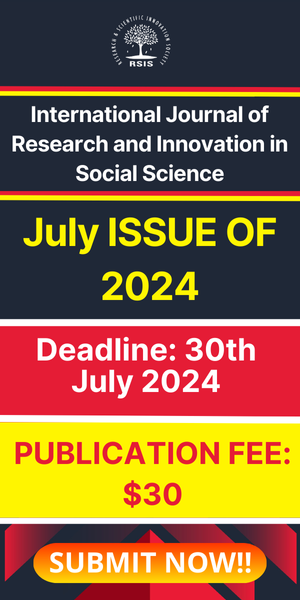Relative Effectiveness of Peer Assessment Technique (PAT) in Enhancing Secondary School Students’ Academic Achievement and Interest in Economics
- September 30, 2021
- Posted by: rsispostadmin
- Categories: IJRISS, Social Science
International Journal of Research and Innovation in Social Science (IJRISS) | Volume V, Issue IX, September 2021 | ISSN 2454–6186
Morrison, U. I. (Ph.D), Abanobi, C. C. (Ph.D), Ifemeni, A. L.
Department of Educational Foundations, Federal College of Education (Technical), Asaba
Abstract: Successful implementation of continuous assessment in schools depends on effective and efficient use of a variety of assessment techniques to determine students’ learning outcomes. Among these various techniques are the peer assessment technique (PAT), teacher assessment technique (TAT) among others. This study examined relative effectiveness of PAT in enhancing secondary school students’ academic achievement and interest in Economics. Six research questions and six null hypotheses guided the study. The study adopted a quasi-experimental research design. 1,750 SS II students in twelve (12) secondary schools in Delta North Education Zone (Ministry of Education, Exams and Standard, Asaba) comprised the population of the study. The sample of this study comprised 107 (49 males and 58 females) SSII students who offered Economics from two co-educational secondary schools in Oshimili South Local Government Area, Delta North Education Zone of Delta State. The instruments for data collection were Economics Achievement Test (EAT) and Economics Interest Inventory (EII). The EAT and EII were validated by subject specialists and measurement and evaluation experts. The reliability coefficients of EAT and EII were 0.95 and 0.81 respectively. Mean and standard deviation were used to answer the research questions. Analysis of Covariance (ANCOVA) was used to test the null hypotheses at 0.05 level of significance. The findings revealed among others that the mean achievement scores of students exposed to TAT is higher than that of those exposed to PAT and the difference in their mean achievement scores is significant. Students exposed to TAT have more interest than those exposed to PAT but the difference in their mean interest scores is not significant. Based on the findings, the study recommended among others that secondary school authorities should use only TAT for assessment of secondary school students’ academic achievement in all secondary schools.
Keywords: Academic Achievement, Interest, Peer Assessment Technique, Teacher Assessment Technique
I. INTRODUCTION
The act of assessment seems to be as old as mankind because it is a tool used to evaluate performance and maintain standard using sets of criteria. Assessors set bench marks to judge the work of students in and out of the classroom. Assessment is an integral part of instruction as it determines whether or not the goals of education are being met. Assessment affects decisions about students’ grades, placement, advancement and instructional needs. Edutopia (2014) has it that assessment inspires one to ask these hard questions: Are teachers teaching what is to be taught? Are students learning what they are supposed to learn? Is there a particular way to teach, thereby promoting better learning? Therefore, the role of assessment cannot be over-emphasized.


